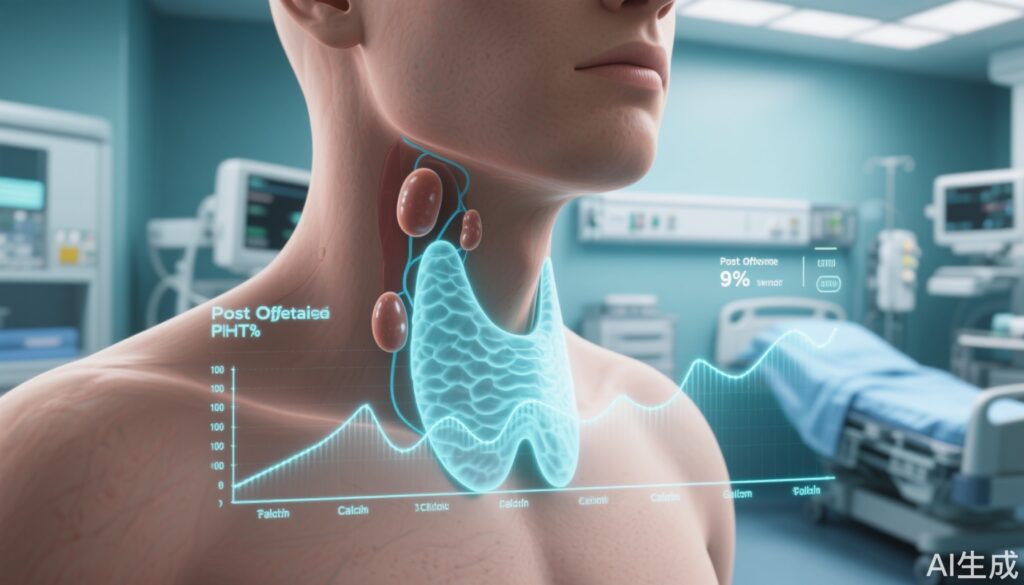Highlight
– Early measurement of parathyroid hormone (PTH) levels at 6 hours post-total thyroidectomy is a strong predictor of both transient and permanent hypoparathyroidism.
– A threshold of PTH < 10.10 pg/mL at 6 hours post-op demonstrated high accuracy in identifying patients at risk, with AUCs of 0.991 (transient) and 0.961 (permanent hypoparathyroidism).
– Each unit increase in PTH at 6 hours was associated with a 38% reduced risk of developing permanent hypoparathyroidism.
– The protocol enables more efficient risk stratification, potentially shortening hospital stays and reducing healthcare costs.
Background
Total thyroidectomy, a common surgical intervention for benign and malignant thyroid disorders, carries a significant risk of postoperative hypoparathyroidism, resulting from inadvertent damage or devascularization of the parathyroid glands. This complication can lead to hypocalcemia, requiring prolonged calcium supplementation and hospitalization. Accurately predicting which patients will develop transient or permanent hypoparathyroidism is crucial for optimizing postoperative care, reducing morbidity, and improving resource utilization. However, clinical prediction remains challenging due to variable presentation and the lack of universally accepted early biomarkers.
Study Overview and Methodological Design
Segarra-Balao and colleagues conducted a prospective cohort study at a Spanish hospital from September 2021 to November 2023, enrolling 104 patients (mean age 54.9 years, 80% women) who underwent either first-time total thyroidectomy for multinodular goiter, Graves disease, thyroid cancer, or completion thyroidectomy. The study excluded patients with prior parathyroid dysfunction or incomplete follow-up.
The primary aim was to evaluate whether a single measurement of PTH at 6 hours post-surgery could predict the development of hypocalcemia and permanent hypoparathyroidism. Secondary endpoints included the correlation between early PTH levels and corrected serum calcium concentrations at 24 and 48 hours, as well as at 12-month follow-up.
Transient hypoparathyroidism was operationally defined as corrected serum calcium < 8 mg/dL requiring calcium supplementation during hospitalization and at discharge; permanent hypoparathyroidism was defined as corrected calcium < 8 mg/dL or PTH < 15 pg/mL at 12 months.
PTH was measured at 6 hours postoperatively, while protein-corrected serum calcium was measured at 24 and 48 hours. All patients were monitored for the development of symptoms and biochemical evidence of hypoparathyroidism, with follow-up extending through 12 months.
Key Findings
Of the 104 patients, 26.7% developed transient hypoparathyroidism and 15.4% developed permanent hypoparathyroidism. Patients in these groups exhibited significantly lower corrected serum calcium at 24 and 48 hours, as well as lower PTH at 6 hours post-surgery (P < .05 for all comparisons).
A PTH level < 10.10 pg/mL at 6 hours postoperatively provided excellent discrimination for both transient (AUC 0.991, 95% CI 0.978-1.000) and permanent hypoparathyroidism (AUC 0.961, 95% CI 0.925-0.997). The odds ratio for risk reduction per unit increase in PTH was 0.62 (P = .001), indicating that higher early PTH is strongly protective.
These findings support the value of a single, early PTH measurement as a reliable biomarker for postoperative risk stratification.
| Outcome | Incidence | AUC (95% CI) | PTH Threshold (pg/mL) |
|---|---|---|---|
| Transient Hypoparathyroidism | 26.7% | 0.991 (0.978-1.000) | < 10.10 |
| Permanent Hypoparathyroidism | 15.4% | 0.961 (0.925-0.997) | < 10.10 |
Mechanistic Insights and Pathophysiological Context
Hypoparathyroidism after total thyroidectomy arises primarily from direct trauma or devascularization of the parathyroid glands, leading to insufficient PTH secretion and subsequent hypocalcemia. Recovery of parathyroid function depends on the extent of injury and the presence of viable parathyroid tissue. Early postoperative PTH levels reflect the immediate functional reserve of the parathyroid glands, providing a sensitive measure of injury that precedes serum calcium decline, which is delayed due to calcium buffering and physiological adaptation.
The strong predictive value of PTH at 6 hours supports the biological plausibility of early hormone measurement as an indicator of both transient (reversible injury) and permanent (irreversible damage or loss) hypoparathyroidism.
Clinical Implications
Routine measurement of PTH 6 hours post-thyroidectomy offers a practical and cost-effective approach to identifying patients at high risk of hypocalcemia. Those with PTH < 10.10 pg/mL can be targeted for early intervention, such as calcium and active vitamin D supplementation, while patients with higher PTH may be safely considered for early discharge with minimal risk.
This risk stratification protocol could facilitate shorter hospital stays, reduce unnecessary laboratory monitoring, and decrease healthcare costs—all while improving patient outcomes through proactive management. The study aligns with growing evidence advocating for early PTH-guided postoperative care in thyroid surgery.
Limitations and Controversies
The study was conducted at a single center with a relatively modest sample size, which may limit generalizability. Additionally, the inclusion of a predominantly female population reflects thyroid disease epidemiology but may not capture sex-specific differences in recovery. The cutoff of 10.10 pg/mL, while highly accurate in this cohort, could vary depending on assay methodology and patient factors. Further multicenter validation is warranted.
Some experts argue that reliance on early PTH alone may overlook delayed or atypical recovery, and that combined calcium and PTH monitoring could be more comprehensive. There is also ongoing debate around definitions of permanent hypoparathyroidism (with some guidelines using 6 months instead of 12 months as a threshold).
Expert Commentary or Guideline Positioning
Current American Thyroid Association (ATA) and European Thyroid Association (ETA) guidelines recognize the utility of early PTH measurement in post-thyroidectomy care, emphasizing its role in guiding supplementation and discharge planning. The present study adds robust evidence for a single 6-hour measurement, supporting its integration into standardized postoperative pathways.
Conclusion
Early postoperative PTH measurement at 6 hours offers a highly accurate, actionable biomarker for predicting hypoparathyroidism following total thyroidectomy. Adoption of this protocol can enhance patient safety, streamline care, and reduce costs. Larger, multicenter studies and harmonization of thresholds are needed to confirm generalizability and refine clinical guidelines.
References
– Segarra-Balao A, Barranco-Ochoa JD, de Damas-Medina M, et al. A PTH Value at 6 Hours Post-Surgery Predicts the Diagnosis of Transient and Permanent Hypoparathyroidism. J Clin Endocrinol Metab. 2025 Jul 17:dgaf416. doi: 10.1210/clinem/dgaf416. Epub ahead of print. PMID: 40671592.
– American Thyroid Association (ATA) Statement on Postoperative Management Following Thyroidectomy. Thyroid. 2016;26(2):215-217.
– Lorente-Poch L, et al. Defining the syndromes of parathyroid insufficiency after total thyroidectomy. Gland Surg. 2015;4(1):82-90.



